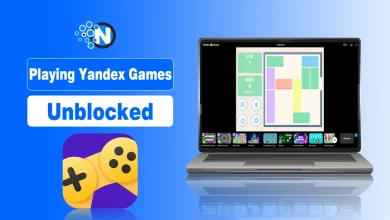How Modern Tech Powers Classic Arcade Hits

Arcade games were once the heartbeat of pop culture, buzzing neon rooms filled with the clatter of coins, the glow of CRT screens, and the thrill of chasing high scores.
Due to the rapid advancements in modern tech, from cloud computing and AI to VR and mobile platforms, classic arcade hits have found new life in the digital age.
Behind the scenes, today’s cabinets are small computers with smart inputs, fast graphics, and connected features. Operators planning a game room can scan arcade games by category, compare footprints, and match formats to their floor and audience.
Players get the nostalgia they expect with the polish they see on home consoles.
In this blog post, I will explore how modern technology has transformed the way we play, experience, and connect with classic arcade games.

The Tech Evolution of Arcade Classics
Controls Feel Familiar, Inputs Got Smarter
Real play starts at the panel. Modern cabinets still use wheels, sticks, pedals, and buttons in arcade games, but the parts are more precise and easier to service. Optical encoders in racing wheels reduce drift. Hall-effect joysticks cut wear. Load-cell brake pedals make pressure feel more like a real car.
Touch panels are common on redemption and rhythm titles for fast menus, age checks, and tutorials. Motion tracking shows up in boxing and dance games, while improved cameras help with pose detection.
Haptics move beyond simple rumbles. Seat shakers, bass transducers, and directional feedback add cues that help players judge speed, hits, and lane position. The science behind tactile feedback dates back decades and has become mainstream in both consumer tech and cabinets.
Good inputs also mean fewer lineups for repairs. Quick-swap button clusters and modular gun housings let techs replace parts in minutes. That uptime matters on weekends and holidays when traffic spikes.
Graphics Jumped, Gameplay Stayed Fast
Classic sprites still look great, but many modern remakes use 3D engines and monitors with high refresh rates. A 1080p or 4K panel with strong brightness keeps colors clear in busy arcades.
Synchronized lighting around the bezel and under the cabinet ties visuals to events like combos and jackpots.
Frame pacing matters more than raw resolution. Many driving and shooter cabinets target stable frame rates to keep steering and aiming responsive. Adaptive sync and higher refresh can reduce tearing and lag. Paired with better audio amps and discrete subwoofers, the whole cabinet feels more alive without changing the core rules that made the original game fun.
Thermal design is another quiet upgrade. Larger heatsinks, smart fan curves, and dust filters help components run cooler. Less heat means longer life, less throttling, and fewer mid-day resets.
Physics, AI, and Fair Scoring
Modern code adds subtle improvements that most players feel even if they cannot name them. Physics engines handle tire grip, ball spin, and projectile paths with more realism while keeping outcomes fair.
Adjustable assists can bring new players in without making skilled players feel capped.
AI routines now scale difficulty smoothly. Rubber-banding in racers is less abrupt, so you feel pushed but not punished. In light-gun games, aim assist can slide gently at low settings, then back off as accuracy rises.
Machine-readable score logs make audits simple. Operators can spot stuck switches, pay-table errors, or outlier scores that hint at abuse.
When a classic cabinet needs to mimic old behaviors, developers add “legacy mode” rules. That may mean fixed enemy patterns, strict timing windows, or original scoring tables. The goal is to preserve muscle memory while benefiting from modern stability.
Connected Play and Live Ops
Many cabinets now ship with network features. Online leaderboards refresh interest after the first month. Cross-location events pit sites against each other for weekly standings.
Cloud-based updates fix bugs, rebalance difficulty, and add bonus tracks or maps between major releases.
For operators, dashboards help track coin and card swipes per hour, average session length, and cabinet availability. Alerts notify staff when a bill acceptor jams or a hopper runs low. These tools make scheduling and parts ordering more predictable.
Network design also respects privacy and uptime. Cabinets cache scores and receipts when the internet drops, then sync later. Local firewalls and VLANs keep traffic separated from point-of-sale systems.
Simple status lights on the backplane show if power, network, or storage is at fault, which speeds up on-site checks.
Payments, Redemption, and Security
Cash still works in many rooms, but contactless payments are growing. Near Field Communication lets a phone or card start a session with a tap, which reduces queues and ticket jams.
Card systems track play by profile, which supports time-of-day pricing or birthday bonuses without extra admin.
Ticket handling is calmer with digital redemption. Players store points on cards or apps, then check totals at kiosks. That reduces paper waste and back-office counting. Where paper tickets remain, improved ticket paths and sensors reduce misreads.
Security includes more than locks. Firmware signing blocks unapproved code. Encrypted audit files keep earnings and service data intact. Cabinets ship with simple menus to set prices, credits per swipe, and payout ranges, which helps align each title with local rules and site goals.
Service, Parts, and Lifecycle Planning
Even the best cabinet loses value if it is hard to maintain. New designs put filters, fuses, and boards behind tool-less panels. Color-coded harnesses and labeled ports cut guesswork. Standardized power supplies and cooling fans mean shared spares across different models.
Lighting has moved to LEDs with long lifespans and low heat. Solid-state drives replace spinning disks for faster boot and fewer failures. Where space is tight, compact footprints and corner-friendly shapes help you fit more variety on the floor.
Operators also look at total cost across years. That includes energy use, average repair time, spare part prices, and resale demand. Distributors that understand installs, financing, and post-sale support help new sites open faster and keep rooms fresh.
Documentation, training videos, and real service contacts are worth as much as a hit title.
Picking the Right Modern Remake
A strong lineup blends nostalgia with audience fit. For family spots, low-threshold racers, basketball, and claw machines pull steady traffic. For teen groups, rhythm games and shooters add competition and repeat visits.
If your base loves retro, look for remakes that keep the original scoring and pacing while adding cleaner art, better sound, and comfort features like adjustable seats.
Check the three basics before purchase. First, test inputs. The wheel, stick, or gun should feel stable, not spongy. Second, watch a full game loop. Is the tutorial clear, are retries quick, and do players smile at the finish. Third, review service access. You want quick reach to coin doors, filters, and I/O boards without moving the cabinet far.
Financing and lease options can spread costs across seasons. Pair a new anchor cabinet with proven earners so cash flow stays steady while the new title builds buzz. Map upgrades across the year, not all at once. That keeps the room fresh and makes staffing easier.
Final Thoughts
A modern cabinet is still about simple fun. The tech fades into the background the moment the countdown starts and the music kicks in. Players get the feel they remember with the polish they expect today.
Operators get better uptime, clearer data, and safer installs. Whether you’re chasing high scores or reliving childhood memories, today’s tech ensures the arcade spirit lives on. However, choose the remakes that respect the core game, then use the new tools to keep the play fair, fast, and fresh.




